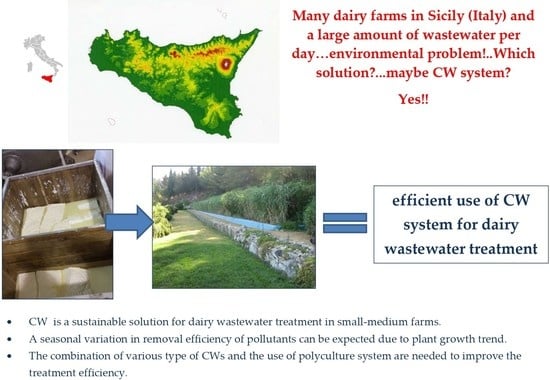Treatment of Combined Dairy and Domestic Wastewater with Constructed Wetland System in Sicily (Italy). Pollutant Removal Efficiency and Effect of Vegetation
Abstract
1. Introduction
2. Materials and Methods
2.1. Test Site
2.2. Description of the HSSFs CW
2.3. Plant Measurements
2.4. DWW Analysis
2.5. Weather Data
2.6. Statistical Analysis
3. Results and Discussion
3.1. Rainfall and Air Temperature Trends in the HSSFs CW Area
3.2. Monitoring and Pollutants Removal Efficiency of the HSSFs CW
3.3. Plant Growth and Biomass Production
3.4. Effect of Plant Growth on BOD5 and COD RE
4. Conclusions
Author Contributions
Funding
Institutional Review Board Statement
Informed Consent Statement
Data Availability Statement
Acknowledgments
Conflicts of Interest
References
- L’Industria Alimentare in Italia. Available online: www.ismea.it (accessed on 1 October 2020).
- Annual Production Series of Dairy Products. Available online: www.ec.europa.eu (accessed on 10 October 2020).
- Milk and Dairy Products. Available online: www.dati.istat.it (accessed on 21 October 2020).
- Rossi, P.; Marchiorlatti Vignat, I. Caratteristiche dei caseifici dell’area del sisma. In Progetto ERICA: Linee Guida Efficienza Energetica e Rinnovabili per il Caseificio del Futuro, 1st ed.; C.R.P.A.: Regione Emilia-Romagna, Italy, 2013; Volume 1, pp. 12–24. [Google Scholar]
- Sanna, M. Antinquinamento delle Industrie Alimentari, 1st ed.; Luigi Scialpi: Rome, Italy, 1982; p. 565. [Google Scholar]
- Matos, A.T.; Freitas, W.S.; Lo Monaco, P.A.V. Eficiéncia de sistemas alagados construídos na remoção de poluentes de águas resíduárias da suinocultura. Ambient. Agua Interdiscip. J. Appl. Sci. 2010, 5, 119–132. [Google Scholar] [CrossRef][Green Version]
- Vourch, M.; Balannec, B.; Chaufer, B.; Dorange, G. Treatment of dairy industry wastewater by reverse osmosis for water reuse. Desalination 2008, 219, 190–202. [Google Scholar] [CrossRef]
- Sarkar, B.; Chakrabarti, P.P.; Vijaykumar, A.; Kale, V. Wastewater treatment in dairy industries—Possibility of reuse. Desalination 2006, 195, 141–152. [Google Scholar] [CrossRef]
- Prazeres, A.R.; Rivas, J.; Almeida, M.A.; Patanita, M.; Dôres, J.; Carvalho, F. Agricultural reuse of cheese whey wastewater treated by NaOH precipitation for tomato production under several saline conditions and sludge management. Agric. Water Manag. 2016, 167, 2–74. [Google Scholar] [CrossRef]
- Carvalho, F.; Prazeres, A.R.; Rivas, J. Cheese whey wastewater: Characterization and treatment. Sci. Total Environ. 2013, 445–446, 385–396. [Google Scholar] [CrossRef]
- Demirel, B.; Yenigun, O.; Onay, T.T. Anaerobic treatment of dairy wastewaters: A review. Process Biochem. 2005, 40, 2583–2595. [Google Scholar] [CrossRef]
- Akratos, C.S.; van Oirshot, D.; Tekerlekopoulou, A.G.; Vajenas, D.V.; Stefanakis, A. Dairy wastewater treatment with constructed wetlands: Experiences from Belgium, the Netherlands and Greece. In Constructed Wetlands for Industrial Wastewater Treatment, 1st ed.; Stefanakis, A.I., Ed.; John Wiley & Sons, Ltd.: Hoboken, NJ, USA, 2018; Volume 1, pp. 175–198. [Google Scholar]
- Masi, F.; Rizzo, A.; Bresciani, R.; Basile, C. Dairy wastewater treatment by horizontal subsurface flow constructed wetland in southern Italy. In Natural and Constructed Wetlands, 1st ed.; Vymazal, J., Ed.; Springer: Cham, Switzerland, 2016; Volume 1, pp. 131–139. [Google Scholar]
- Pattnaik, R.; Yost, R.S.; Porter, G.; Masunaga, T.; Attanandana, T. Improving multi-soil-layer (MSL) system remediation of dairy effluent. Ecol. Eng. 2007, 32, 1–10. [Google Scholar] [CrossRef]
- Prazeres, A.R.; Carvalho, F.; Rivas, J. Cheese whey management: A review. J. Environ. Manag. 2012, 110, 48–68. [Google Scholar] [CrossRef] [PubMed]
- Farizoglu, B.; Keskinler, B.; Yildiz, E.; Nuhoglu, A. Cheese whey treatment performance of an aerobic jet loop membrane bioreactor. Process Biochem. 2004, 39, 2283–2291. [Google Scholar] [CrossRef]
- Smithers, G.W. Whey and whey proteins—From “gutter-to-gold”. Int. Dairy J. 2008, 18, 695–704. [Google Scholar] [CrossRef]
- OECD–FAO. Agricultural Outlook 2008–2017, Highlights. Available online: www.agris.fao.org (accessed on 3 November 2020).
- Prazeres, A.R.; Carvalho, F.; Rivas, J.; Patanita, M.; Dôres, J. Growth and development of tomato plants Lycopersicon esculentum Mill. under different saline conditions by fertirrigation with pretreated cheese whey wastewater. Water Sci. Technol. 2013, 67, 2033–2041. [Google Scholar] [CrossRef]
- Prazeres, A.R.; Carvalho, F.; Rivas, J.; Patanita, M.; Dôres, J. Pretreated cheese whey wastewater management by agricultural reuse: Chemical characterization and response of tomato plants Lycopersicon esculentum Mill. under salinity conditions. Sci. Total Environ. 2013, 463–464, 943–951. [Google Scholar] [CrossRef]
- Hawke, R.; Summers, S. Effects of land application of farm dairy effluent on soil properties: A literature review. N. Z. J. Agric. Res. 2006, 49, 307–320. [Google Scholar] [CrossRef]
- Liu, Y.Y.; Haynes, R. Effect of long-term irrigation with dairy factory wastewater on soil properties. In Proceedings of the 19th World Congress of Soil Science, Soil Solutions for a Changing World, Brisbane, Australia, 1–6 August 2010; pp. 70–73. [Google Scholar]
- Ibekwe, A.M.; Grieve, C.M.; Lyon, S.R. Characterization of Microbial Communities and Composition in Constructed Dairy Wetland Wastewater Effluent. Appl. Environ. Microbiol. 2003, 69, 5060–5069. [Google Scholar] [CrossRef]
- Schierano, M.C.; Panigatti, M.C.; Maine, M.A.; Griffa, C.A.; Boglione, R. Horizontal subsurface flow constructed wetland for tertiary treatment of dairy wastewater: Removal efficiencies and plant uptake. J. Environ. Manag. 2020, 272, 111094. [Google Scholar] [CrossRef] [PubMed]
- Ahmad, T.; Aadil, R.M.; Ahmed, H.; Rahman, U.U.; Soares, B.C.; Souza, S.L.; Pimentel, T.C.; Scudino, H.; Guimarães, J.T.; Esmerino, E.A.; et al. Treatment and utilization of dairy industrial waste: A review. Trends Food Sci. Technol. 2019, 88, 361–372. [Google Scholar] [CrossRef]
- Kushwaha, J.P.; Srivastava, V.C.; Mall, I.D. An Overview of Various Technologies for the Treatment of Dairy Wastewaters. Crit. Rev. Food Sci. Nutr. 2011, 51, 442–452. [Google Scholar] [CrossRef] [PubMed]
- Licata, M.; Tuttolomondo, T.; Virga, G.; Leto, C.; La Bella, S. The use of constructed wetlands for the treatment of agro-industrial wastewater—A case study in a dairy-cattle farm in Sicily (Italy). Desalin. Water Treat. 2017, 76, 300–310. [Google Scholar] [CrossRef]
- Mantovi, P.; Marmiroli, M.; Maestri, E.; Tagliavini, S.; Piccinini, S.; Marmiroli, N. Application of a horizontal subsurface flow constructed wetland on treatment of dairy parlor wastewater. Bioresour. Technol. 2003, 88, 85–94. [Google Scholar] [CrossRef]
- Gorra, R.; Freppaz, M.; Zanini, E.; Scalenghe, R. Mountain dairy wastewater treatment with the use of a ‘irregularly shaped’ constructed wetland (Aosta Valley, Italy). Ecol. Eng. 2014, 73, 176–183. [Google Scholar] [CrossRef]
- Comino, E.; Riggio, V.; Rosso, M. Mountain cheese factory wastewater treatment with the use of a hybrid constructed wetland. Ecol. Eng. 2011, 37, 1673–1680. [Google Scholar] [CrossRef]
- Mantovi, P.; Piccinini, S.; Lina, F.; Marmiroli, N.; Marmiroli, N. Treating wastewaters from cheese production in H-SSFs con-structed wetlands. In Proceedings of the International Conference Multifunctions of Wetland Systems, Padova, Italy, 26–29 June 2007; pp. 72–73. [Google Scholar]
- Sultana, M.Y. Treatment of Industrial and Agro-Industrial Wastewater Using Constructed Wetlands. Ph.D. Thesis, School of Engineering, University of Patras, Patras, Greece, 18 November 2014. [Google Scholar]
- Sultana, M.-Y.; Mourti, C.; Tatoulis, T.; Akratos, C.S.; Tekerlekopoulou, A.G.; Vayenas, D.V. Effect of hydraulic retention time, temperature, and organic load on a horizontal subsurface flow constructed wetland treating cheese whey wastewater. J. Chem. Technol. Biotechnol. 2015, 91, 726–732. [Google Scholar] [CrossRef]
- Vymazal, J. The use constructed wetlands with horizontal sub-surface flow for various types of wastewater. Ecol. Eng. 2009, 35, 1–17. [Google Scholar] [CrossRef]
- Nguyen, L.M. Organic matter composition, microbial biomass and microbial activity in gravel-bed constructed wetlands treating farm dairy wastewaters. Ecol. Eng. 2000, 16, 199–221. [Google Scholar] [CrossRef]
- Leto, C.; Tuttolomondo, T.; La Bella, S.; Leone, R.; Licata, M. Growth of Arundo donax L. and Cyperus alternifolius L. in a hor-izontal subsurface flow constructed wetland using pre-treated urban wastewater—A case study in Sicily (Italy). Desalin. Water Treat. 2013, 251, 7447–7459. [Google Scholar] [CrossRef]
- Allen, R.G.; Pereira, L.S.; Raes, D.; Smith, M. Introduction to crop evapotranspiration (ETc). In Crop Evapotranspiration: Guidelines for Computing Crop Requirements—FAO Irrigation and Drainage Paper 56, 1st ed.; FAO: Rome, Italy, 1998; Volume 1, pp. 89–102. [Google Scholar]
- APAT; CNR-IRSA. Metodi Analitici Per le Acque. Agenzia per la Protezione dell’Ambiente e per i Servizi Tecnici, Con-siglio Nazionale delle Ricerche, 1st ed.; Istituto di Ricerca sulle Acque: Rome, Italy, 2004; 1149p. [Google Scholar]
- Standard Methods for the Examination of Water and Wastewater, 19th ed.American Public Health Association: Washington, DC, USA, 1998.
- Kadlec, R.H.; Knight, R.L.; Vymazal, J.; Brix, H.; Cooper, P.; Haberl, R. Constructed Wetlands for Pollution Control: Processes, Performance, Design and Operation, 1st ed.; International Water Association Publishing: London, UK, 2000; pp. 17–90. [Google Scholar]
- Servizio Informativo Agrometeorologico Siciliano. Available online: www.sias.regione.sicilia.it (accessed on 24 January 2021).
- Kottek, M.; Grieser, J.; Beck, C.; Rudolf, B.; Rubel, F. World Map of the Köppen-Geiger climate classification updated. Meteorol. Z. 2006, 15, 259–263. [Google Scholar] [CrossRef]
- Brewer, A.; Cumby, T.; Dimmock, S. Dirty water from dairy farms, II: Treatment and disposal options. Bioresour. Technol. 1999, 67, 161–169. [Google Scholar] [CrossRef]
- Vymazal, J. Constructed wetlands for treatment of industrial wastewaters: A review. Ecol. Eng. 2014, 73, 724–751. [Google Scholar] [CrossRef]
- Brix, H.; Sorrell, B.K.; Lorenzen, B. Are Phragmites-dominated wetlands a net source or net sink of greenhouse gases? Aquat. Bot. 2001, 69, 313–324. [Google Scholar] [CrossRef]
- Chen, D.; Gu, X.; Zhu, W.; He, S.; Wu, F.; Huang, J.; Zhou, W. Denitrification- and anammox-dominant simultaneous nitri-fication, anammox and denitrification (SNS) process in subsurface flow constructed wetlands. Biores. Technol. 2019, 271, 298–305. [Google Scholar] [CrossRef]
- Beebe, D.A.; Castle, J.W.; Molz, F.J.; Rodgers, J.H., Jr. Effects of evapotranspiration on treatment performance in constructed wetlands: Experimental studies and modeling. Ecol. Eng. 2014, 71, 394–400. [Google Scholar] [CrossRef]
- Headley, T.; Davison, L.; Huett, D.; Müller, R. Evapotranspiration from subsurface horizontal flow wetlands planted with Phragmites australis in sub-tropical Australia. Water Res. 2012, 46, 345–354. [Google Scholar] [CrossRef]
- Licata, M.; Tuttolomondo, T.; Leto, C.; La Bella, S.; Virga, G. The use of constructed wetlands for the treatment and reuse of urban wastewater for the irrigation of two warm-season turfgrass species under Mediterranean climatic conditions. Water Sci. Technol. 2017, 76, 459–470. [Google Scholar] [CrossRef]
- Pedescoll, A.; Sidrach-Cardona, R.; Sánchez, J.; Bécares, E. Evapotranspiration affecting redox conditions in horizontal constructed wetlands under Mediterranean climate: Influence of plant species. Ecol. Eng. 2013, 58, 335–343. [Google Scholar] [CrossRef]
- Tuttolomondo, T.; Licata, M.; Leto, C.; Leone, R.; La Bella, S. Effect of plant species on water balance in a pilot-scale horizontal subsurface flow constructed wetland planted with Arundo donax L. and Cyperus alternifolius L.—Two-year tests in a Mediterranean environment in the West of Sicily (Italy). Ecol. Eng. 2015, 74, 79–92. [Google Scholar] [CrossRef]
- La Bella, S.; Tuttolomondo, T.; Leto, C.; Bonsangue, G.; Leone, R.; Virga, G.; Licata, M. Pollutant removal efficiency of a pi-lot-scale Horizontal Subsurface Flow in Sicily (Italy) planted with Cyperus alternifolius L. and Typha latifolia L. and reuse of treated wastewater for irrigation of Arundo donax L. for pellet production—Results of two-year tests under Mediterranean climatic conditions. Desalin. Water Treat. 2016, 57, 22743–22763. [Google Scholar]
- Cooper, P.F.; Job, G.D.; Green, M.B.; Shutes, R.B.E. Reed Beds and Constructed Wetlands for Wastewater Treatment; WRc Publications: Marlow, UK, 1996. [Google Scholar]
- Lee, M.S.; Drizo, A.; Rizzo, D.M.; Druschel, G.; Hayden, N.; Twohig, E. Evaluating the efficiency and temporal variation of pilot-scale constructed wetlands and steel slag phosphorus removing filters for treating dairy wastewater. Water Res. 2010, 44, 4077–4086. [Google Scholar] [CrossRef] [PubMed]
- Kato, K.; Inoue, T.; Ietsugu, H.; Sasaki, H.; Harada, J.; Kitagawa, K.; Sharma, P.K. Design and performance of hybrid con-structed wetland systems for high-content wastewater treatment in the cold climate of Hokkaido, northern Japan. Water Sci. Technol. 2013, 68, 1468–1476. [Google Scholar] [CrossRef] [PubMed]
- Saeed, T.; Sun, G. A comprehensive review on nutrients and organics removal from different wastewaters employing sub-surface flow constructed wetlands. Crit. Rev. Environ. Sci. Technol. 2017, 47, 203–288. [Google Scholar] [CrossRef]
- Gasiunas, V.; Strusevicius, Z.; Struseviciene, M.-S. Pollutant Removal by Horizontal Subsurface Flow Constructed Wetlands in Lithuania. J. Environ. Sci. Health Part A 2005, 40, 1467–1478. [Google Scholar] [CrossRef] [PubMed]
- Lin, Y.F.; Jing, S.R.; Lee, D.Y.; Wang, T.W. Nutrient removal from aquaculture wastewater using a constructed wetlands sys-tem. Aquaculture 2002, 209, 169–184. [Google Scholar] [CrossRef]
- Lu, S.; Zhang, X.; Wang, J.; Pei, L. Impacts of different media on constructed wetlands for rural household sewage treatment. J. Clean. Prod. 2016, 127, 325–330. [Google Scholar] [CrossRef]
- Maine, M.A.; Suñe, N.; Hadad, H.; Sánchez, G.; Bonetto, C. Influence of vegetation on the removal of heavy metals and nu-trients in a constructed wetland. J. Environ. Manag. 2009, 90, 355–363. [Google Scholar] [CrossRef] [PubMed]
- Di Luca, G.; Maine, M.; Mufarrege, M.; Hadad, H.; Bonetto, C. Influence of Typha domingensis in the removal of high P concentrations from water. Chemosphere 2015, 138, 405–411. [Google Scholar] [CrossRef] [PubMed]
- Dunne, E.; Culleton, N.; O’Donovan, G.; Harrington, R.; Olsen, A. An integrated constructed wetland to treat contaminants and nutrients from dairy farmyard dirty water. Ecol. Eng. 2005, 24, 219–232. [Google Scholar] [CrossRef]
- Brisson, J.; Chazarenc, F. Maximizing pollutant removal in constructed wetlands: Should we pay more attention to macrophyte species selection? Sci. Total Environ. 2009, 407, 3923–3930. [Google Scholar] [CrossRef] [PubMed]
- Hamad, M.T. Comparative study on the performance of Typha latifolia and Cyperus Papyrus on the removal of heavy metals and enteric bacteria from wastewater by surface constructed wetlands. Chemosphere 2020, 260, 127551. [Google Scholar] [CrossRef]
- Vymazal, J. Horizontal sub-surface flow and hybrid constructed wetlands systems for wastewater treatment. Ecol. Eng. 2005, 25, 478–490. [Google Scholar] [CrossRef]
- Wu, S.; Carvalho, P.N.; Müller, J.A.; Manoj, V.R.; Dong, R. Sanitation in constructed wetlands: A review on the removal of human pathogens and fecal indicators. Sci. Total Environ. 2016, 541, 8–22. [Google Scholar] [CrossRef] [PubMed]
- Vymazal, J.; Krőpfelová, L. Growth of Phragmites australis and Phalaris arundinacea in constructed wetlands for wastewater treatment in the Czech Republic. Ecol. Eng. 2005, 25, 606–621. [Google Scholar] [CrossRef]
- Licata, M.; Gennaro, M.C.; Tuttolomondo, T.; Leto, C.; La Bella, S. Research focusing on plant performance in constructed wetlands and agronomic application of treated wastewater—A set of experimental studies in Sicily (Italy). PLoS ONE 2019, 14, e0219445. [Google Scholar] [CrossRef] [PubMed]
- Kantawanichkul, S.; Kladprasert, S.; Brix, H. Treatment of high-strength wastewater in tropical vertical flow constructed wetlands planted with Typha angustifolia and Cyperus involucratus. Ecol. Eng. 2009, 35, 238–247. [Google Scholar] [CrossRef]
- Borin, M.; Salvato, M. Effects of five macrophytes on nitrogen remediation and mass balance in wetland mesocosms. Ecol. Eng. 2012, 46, 34–42. [Google Scholar] [CrossRef]
- Di Luca, G.A.; Mufarrege, M.M.; Hadad, H.R.; Maine, M.A. Nitrogen and phosphorus removal and Typha domingensis tol-erance in a floating treatment wetland. Sci. Total Environ. 2019, 650, 233–240. [Google Scholar] [CrossRef] [PubMed]
- Białowiec, A.; Janczukowicz, W.; Randerson, P.F. Nitrogen removal from wastewater in vertical flow constructed wetlands containing LWA/gravel layers and reed vegetation. Ecol. Eng. 2011, 37, 897–902. [Google Scholar] [CrossRef]
- Saeed, T.; Sun, G. A review on nitrogen and organics removal mechanisms in subsurface flow constructed wetlands: De-pendency on environmental parameters, operating conditions and supporting media. J. Environ. Manag. 2012, 112, 419–448. [Google Scholar] [CrossRef]
- Vymazal, J. Removal of nutrients in various types of constructed wetlands. Sci. Total Environ. 2007, 380, 48–65. [Google Scholar] [CrossRef]
- Manios, T.; Kypriotakis, Z.; Manios, V.; Dialyna, G. Plant Species in a Two-Year-Old Free Water Surface Constructed Wetland Treating Domestic Wastewater in the Island of Crete. J. Environ. Sci. Health Part A 2002, 37, 1327–1335. [Google Scholar] [CrossRef]
- Zhu, S.-X.; Ge, H.-L.; Ge, Y.; Cao, H.-Q.; Liu, N.; Chang, J.; Zhang, C.-B.; Gu, B.-J.; Chang, S.-X. Effects of plant diversity on biomass production and substrate nitrogen in a subsurface vertical flow constructed wetland. Ecol. Eng. 2010, 36, 1307–1313. [Google Scholar] [CrossRef]
- Idris, S.M.; Jones, P.L.; Salzman, S.A.; Croatto, G.; Allison, G. Evaluation of the giant reed (Arundo donax) in horizontal sub-surface flow wetlands for the treatment of recirculating aquaculture system effluent. Environ. Sci. Pollut. Res. 2012, 19, 1159–1170. [Google Scholar] [CrossRef]
- Ciria, M.; Solano, M.; Soriano, P. Role of Macrophyte Typha latifolia in a Constructed Wetland for Wastewater Treatment and Assessment of Its Potential as a Biomass Fuel. Biosyst. Eng. 2005, 92, 535–544. [Google Scholar] [CrossRef]
- Avellan, C.T.; Ardakanian, R.; Gremillion, P. The role of constructed wetlands for biomass production within the wa-ter-soil-waste nexus. Water Sci. Technol. 2007, 75, 2237–2245. [Google Scholar] [CrossRef]
- Cui, L.-H.; Ouyang, Y.; Chen, Y.; Zhu, X.-Z.; Zhu, W.-L. Removal of total nitrogen by Cyperus alternifolius from wastewaters in simulated vertical-flow constructed wetlands. Ecol. Eng. 2009, 35, 1271–1274. [Google Scholar] [CrossRef]
- Kyambadde, J.; Kansiime, F.; Dalhammar, G. Nitrogen and Phosphorus Removal In Substrate-Free Pilot Constructed Wetlands With Horizontal Surface Flow In Uganda. Water Air Soil Pollut. 2005, 165, 37–59. [Google Scholar] [CrossRef]
- Soda, S.; Hamada, T.; Yamaoka, Y.; Ike, M.; Nakazato, H.; Saeki, Y.; Kasamatsu, T.; Sakurai, Y. Constructed wetlands for advanced treatment of wastewater with a complex matrix from a metal-processing plant: Bioconcentration and translocation factors of various metals in Acorus gramineus and Cyperus alternifolius. Ecol. Eng. 2012, 39, 63–70. [Google Scholar] [CrossRef]
- Sharma, P.K.; Takashi, I.; Kato, K.; Ietsugu, H.; Tomita, K.; Nagasawa, T. Seasonal efficiency of a hybrid sub-surface flow constructed wetland system in treating milking parlor wastewater at northern Hokkaido. Ecol. Eng. 2013, 53, 257–266. [Google Scholar] [CrossRef]
- Albuquerque, A.; Albuquerque, A.; Amaral, L.; Nogueira, R. Seasonal variation of nutrient removal in a full-scale horizontal constructed wetland. Energy Procedia 2017, 136, 225–232. [Google Scholar] [CrossRef]
- Zhou, Q.; Zhu, H.; Bañuelos, G.; Yan, B.; Liang, Y.; Yu, X.; Cheng, X.; Chen, L. Effects of Vegetation and Temperature on Nutrient Removal and Microbiology in Horizontal Subsurface Flow Constructed Wetlands for Treatment of Domestic Sewage. Water Air Soil Pollut. 2017, 228, 95. [Google Scholar] [CrossRef]
- Zhu, H.; Zhou, Q.-W.; Yan, B.-X.; Liang, Y.-X.; Yu, X.-F.; Gerchman, Y.; Cheng, X.-W. Influence of vegetation type and temperature on the performance of constructed wetlands for nutrient removal. Water Sci. Technol. 2017, 77, 829–837. [Google Scholar] [CrossRef] [PubMed]
- Karathanasis, A.D.; Potter, C.L.; Coyne, M.S. Vegetation effects on fecal bacteria, BOD, and suspended solid removal in con-structed wetlands treating domestic wastewater. Ecol. Eng. 2003, 20, 157–169. [Google Scholar] [CrossRef]
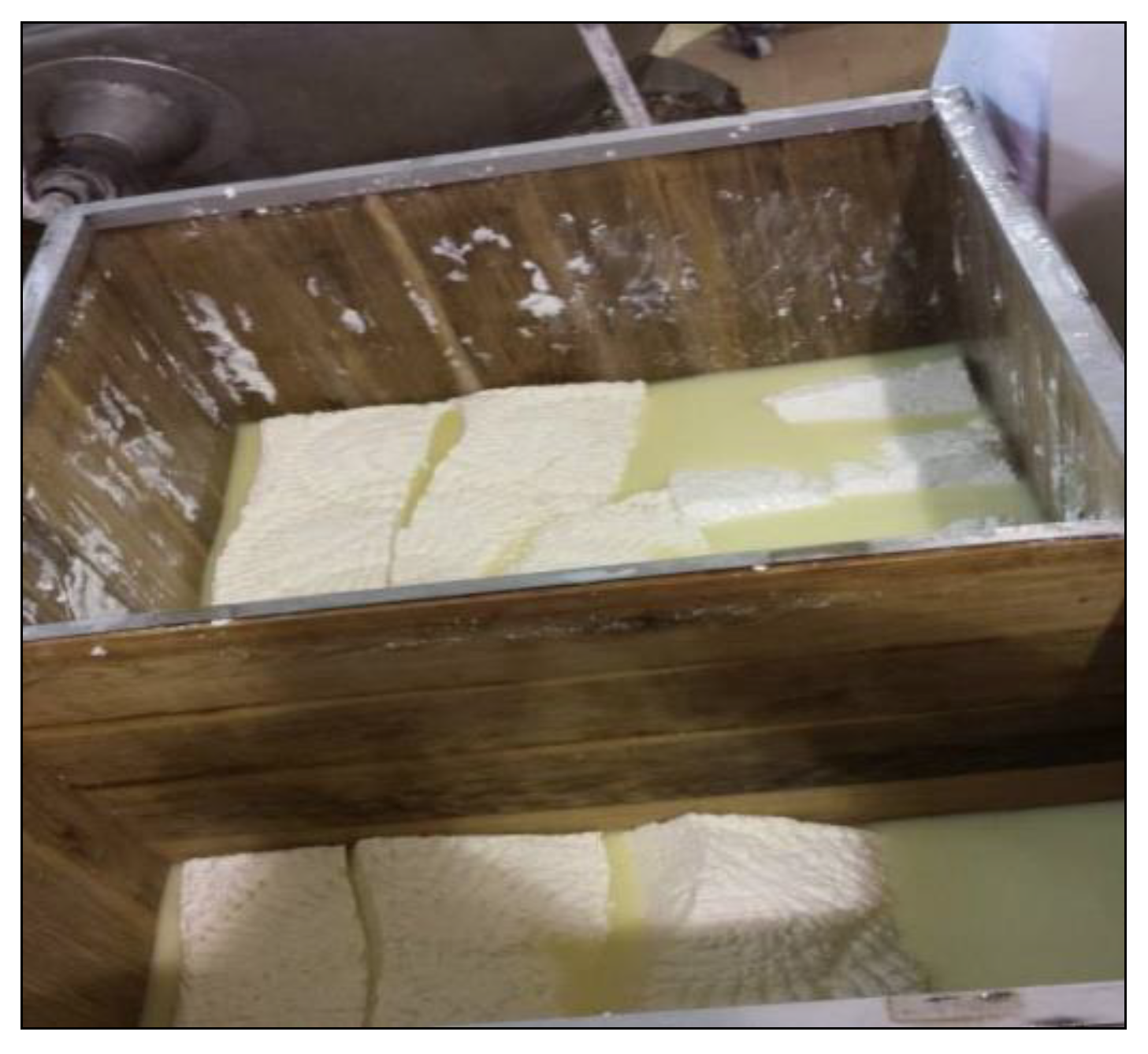
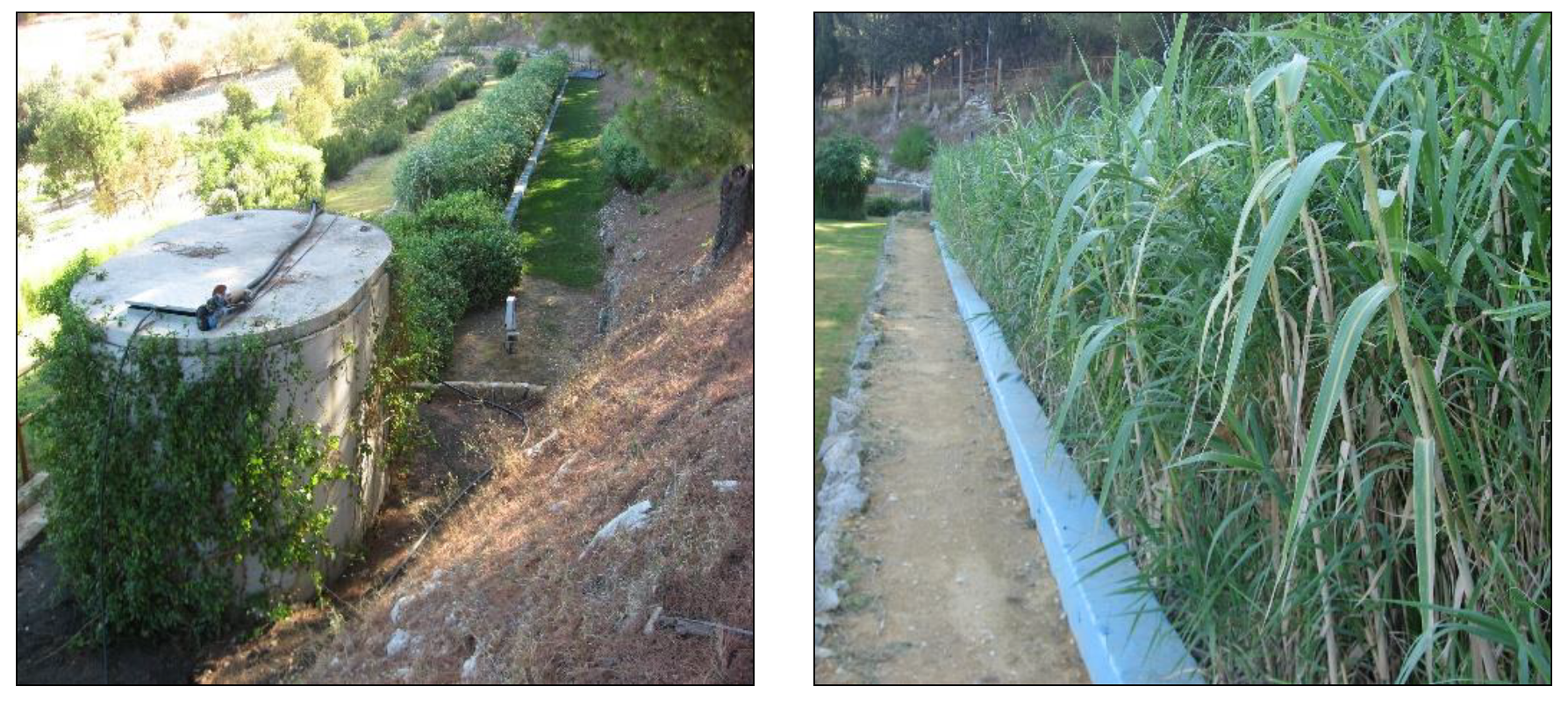

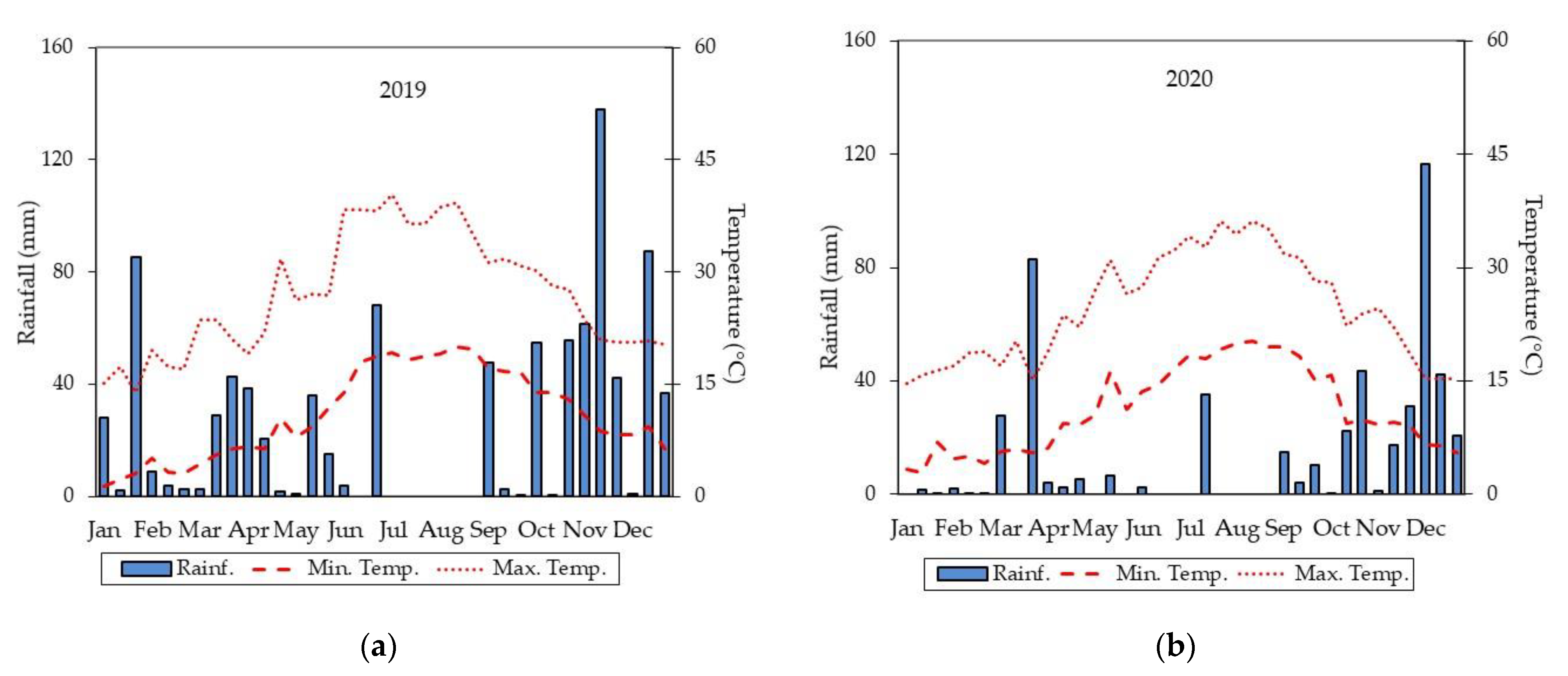
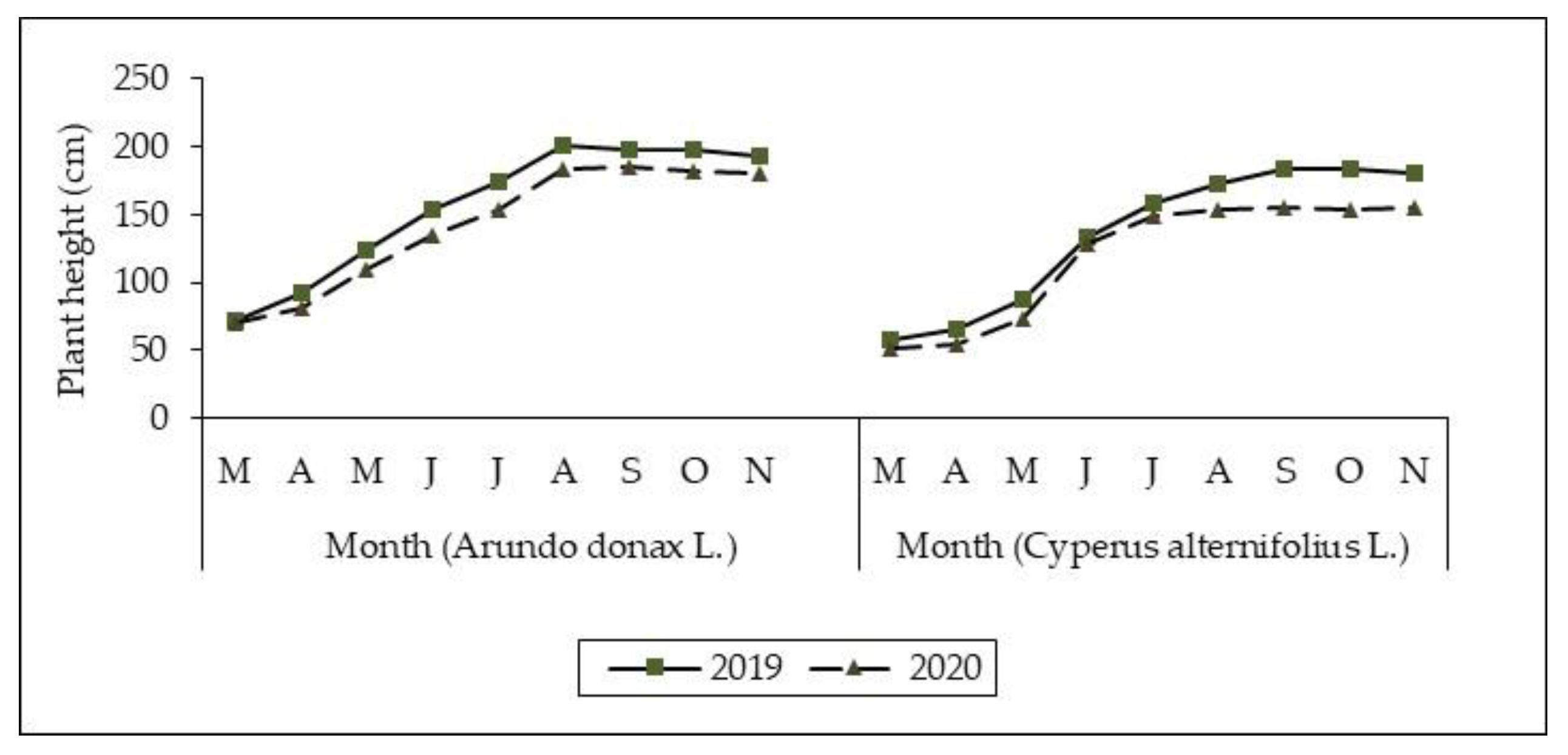
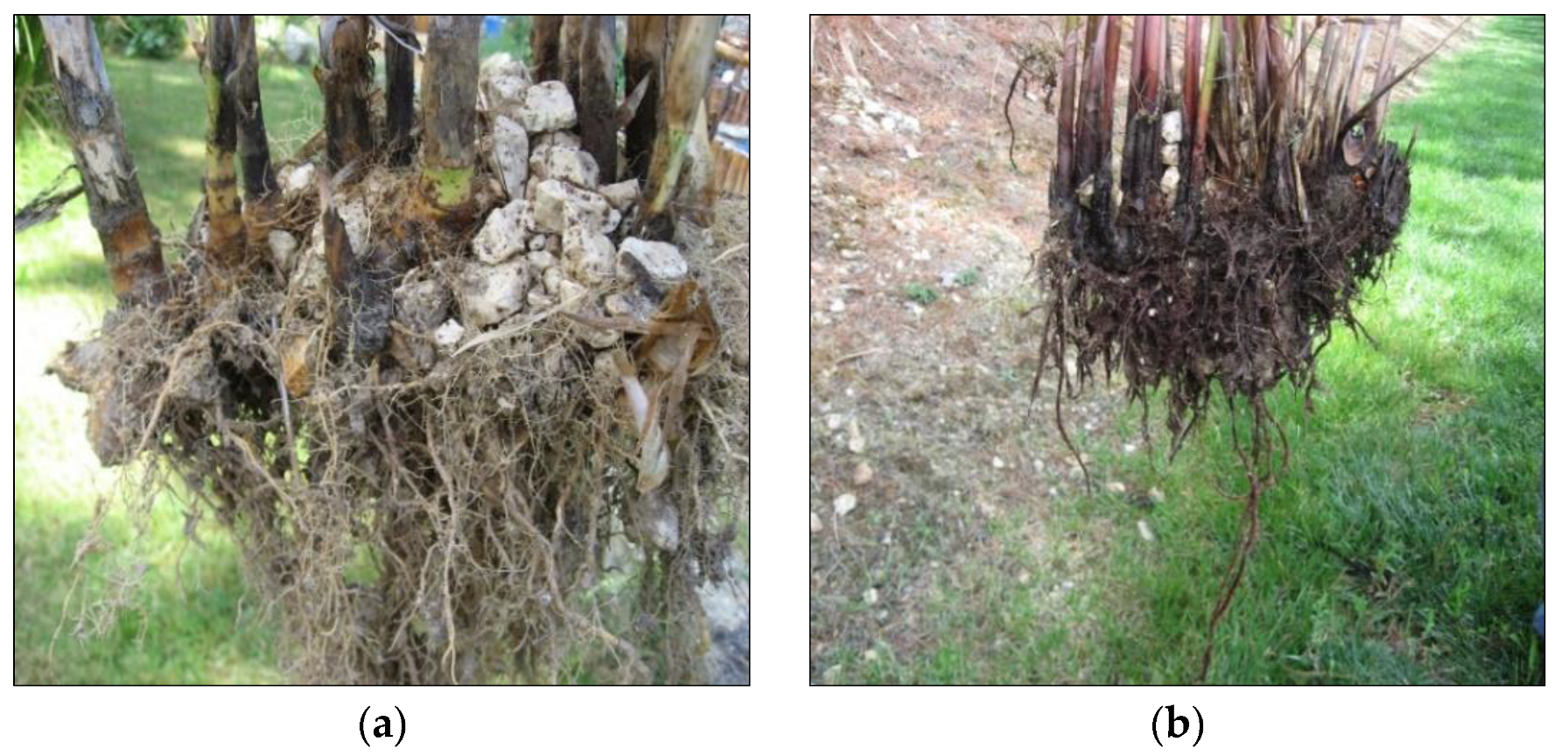
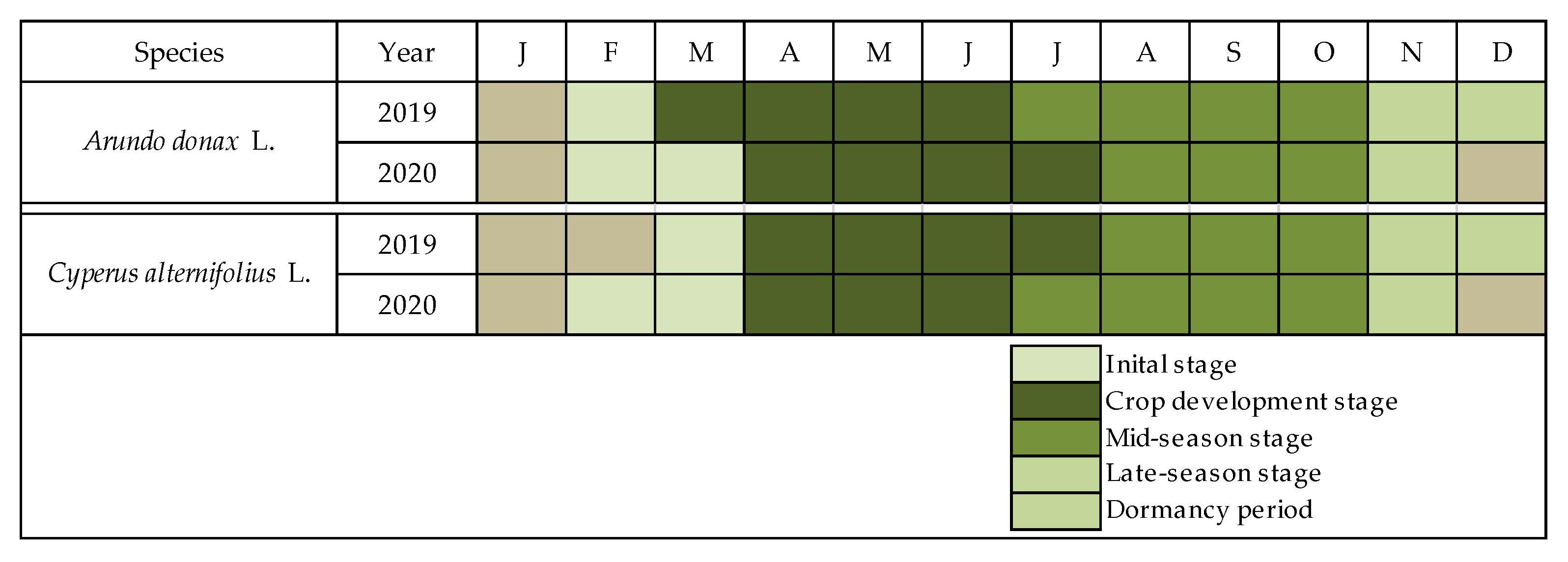
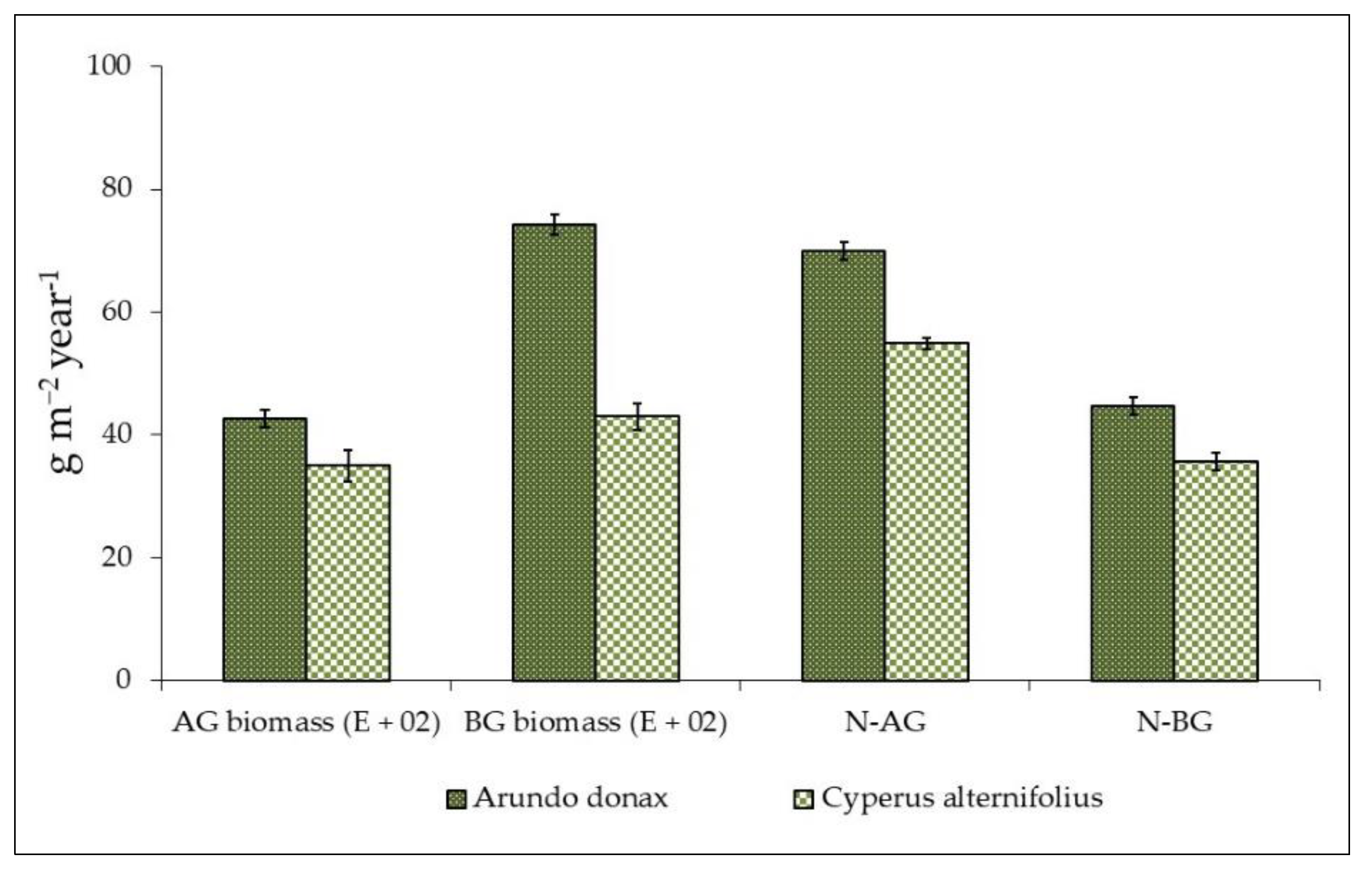
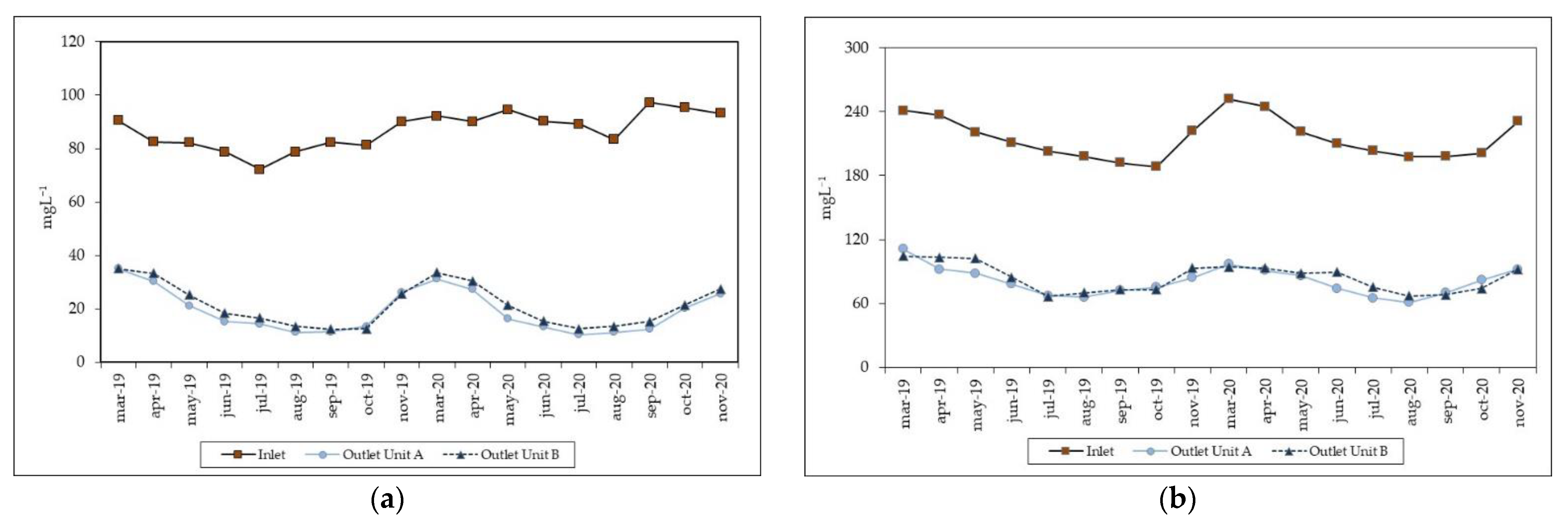
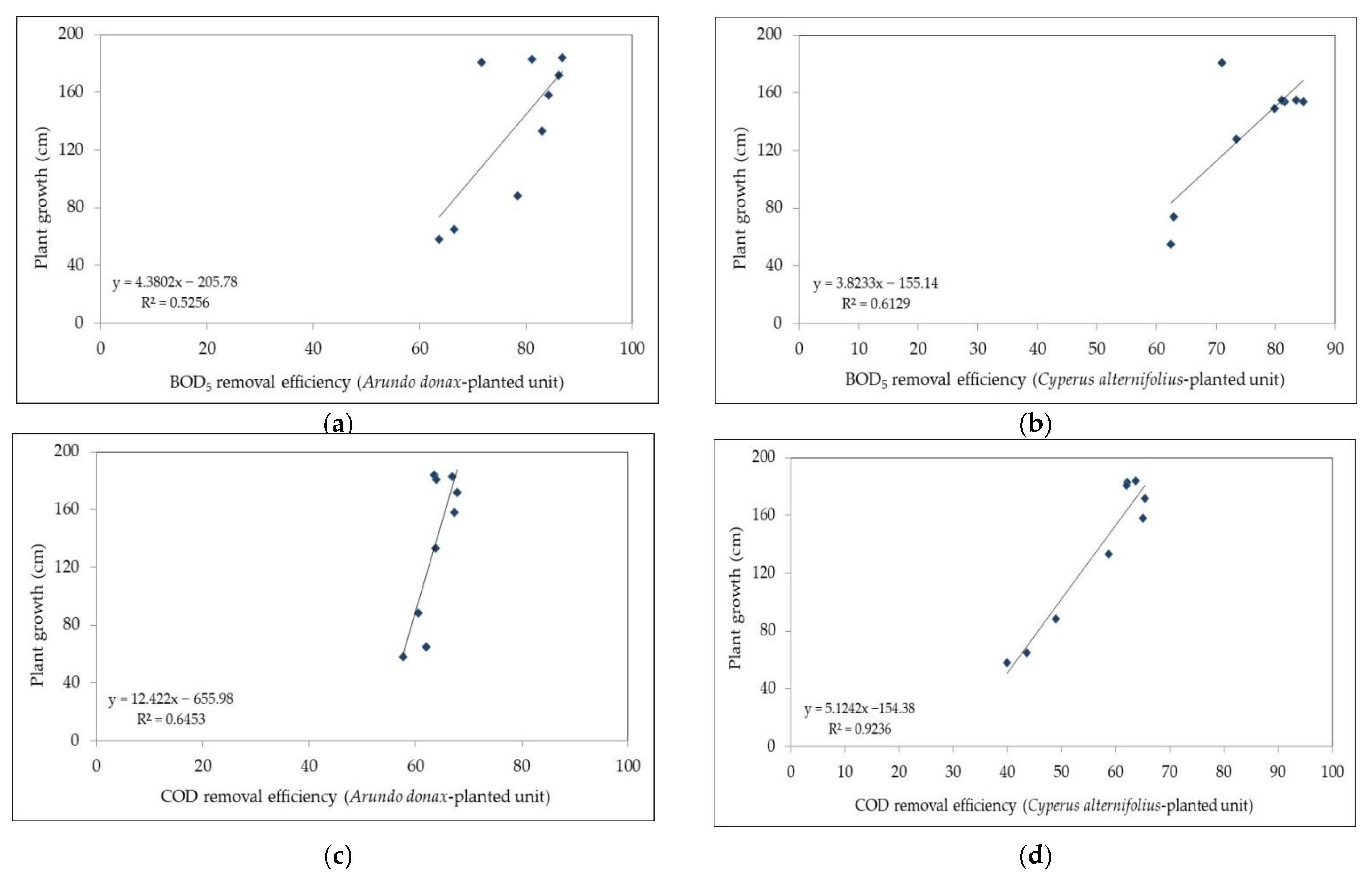
| Parameter | Influent | Effluent 1 | Effluent 2 | VA (%) 1 | VA (%) 2 | Discharge in Soil 3 | t-Test 4 |
|---|---|---|---|---|---|---|---|
| pH | 7.95 ± 0.27 | 7.35 ± 0.18 | 7.30 ± 0.10 | 7.90 | 7.80 | 6–8 | * |
| EC (mS cm−1) | 4.45 ± 1.11 | 5.75 ± 0.98 | 5.43 ± 1.02 | 29.10 | 22.01 | - | * |
| Parameter | Influent | Effluent 1 | Effluent 2 | RE (%) 1 | RE (%) 2 | Discharge in Soil 3 | t-Test 4 |
|---|---|---|---|---|---|---|---|
| Color | P 5 | NP 6 | NP | - | |||
| Odor | NU 7 | NU | NU | - | |||
| Coarse matter | Present | Absent | Absent | Absent | |||
| TSS (mg L−1) | 147.11 ± 0.02 | 24.10 ± 3.35 | 25.89 ± 0.01 | 80.69 | 82.98 | 25 | * |
| BOD5 (mg L−1) | 86.92 ± 6.88 | 19.22 ± 7.49 | 21.27 ± 7.79 | 78.02 | 75.61 | 20 | * |
| COD (mg L−1) | 215.29 ± 9.12 | 80.83 ± 8.53 | 84.12 ± 11.10 | 62.67 | 61.12 | 100 | * |
| TN (mg L−1) | 91.03 ± 3.43 | 43.73 ± 3.41 | 45.72 ± 2.41 | 51.84 | 49.68 | 15 | * |
| N–NH4 (mg L−1) | 62.10 ± 3.45 | 34.12 ± 3.52 | 30.11 ± 3.23 | 45.05 | 51.51 | - | * |
| ON (mg L−1) | 24.12 ± 1.43 | 14.34 ± 1.27 | 13.26 ± 2.11 | 40.51 | 45.11 | - | * |
| TP (mg L−1) | 13.96 ± 0.55 | 8.40 ± 0.29 | 8.53 ± 0.28 | 39.86 | 38.88 | 2 | * |
| Cu (mg L−1) | 0.075 ± 0.001 | 0.042 ± 0.001 | 0.039 ± 0.001 | 44.11 | 48.31 | 0.10 | * |
| Ni (mg L−1) | 0.023 ± 0.001 | 0.015 ± 0.001 | 0.016 ± 0.001 | 35.17 | 31.03 | 0.20 | * |
| Pb (mg L−1) | 0.019 ± 0.001 | 0.013 ± 0.001 | 0.012 ± 0.001 | 31.57 | 36.84 | 0.10 | * |
| Zn (mg L−1) | 0.32 ± 0.002 | 0.14 ± 0.001 | 0.16 ± 0.001 | 56.25 | 50.33 | 0.50 | * |
| Parameter | Influent | Effluent 1 | Effluent 2 | RE 1 | RE 2 | Discharge in Soil 3 | t-Test 4 |
|---|---|---|---|---|---|---|---|
| TC (CFUs 100 mL–1) | 3.97 ± 0.02 5 | 3.19 ± 0.11 | 3.21 ± 0.00 | 83.31 | 82.77 | - | * |
| FS (CFUs 100 mL−1) | 3.85 ± 0.01 | 3.04 ± 0.01 | 3.13 ± 0.01 | 84.32 | 81.17 | - | * |
| Escherichia coli (CFUs 100 mL−1) | 3.91 ± 0.01 | 3.01 ± 0.02 | 3.05 ± 0.02 | 87.44 | 86.48 | ≤3.69 5 | * |
| Salmonella spp. (CFUs 100 mL−1) | Absent | Absent | Absent | - |
| Parameter | CW1 | CW2 |
|---|---|---|
| Culm/stem density (n m−2) | 22.02 ± 2.34 | 87.11 ± 3.55 |
| Culm/stem height (cm) | 149.16 ± 13.44 | 127.66 ± 12.67 |
| Root diameter (cm) | 41.10 ± 2.10 | 32.33 ± 3.31 |
| Root length (cm) | 30.03 ± 1.56 | 28.31 ± 2.03 |
Publisher’s Note: MDPI stays neutral with regard to jurisdictional claims in published maps and institutional affiliations. |
© 2021 by the authors. Licensee MDPI, Basel, Switzerland. This article is an open access article distributed under the terms and conditions of the Creative Commons Attribution (CC BY) license (https://creativecommons.org/licenses/by/4.0/).
Share and Cite
Licata, M.; Ruggeri, R.; Iacuzzi, N.; Virga, G.; Farruggia, D.; Rossini, F.; Tuttolomondo, T. Treatment of Combined Dairy and Domestic Wastewater with Constructed Wetland System in Sicily (Italy). Pollutant Removal Efficiency and Effect of Vegetation. Water 2021, 13, 1086. https://doi.org/10.3390/w13081086
Licata M, Ruggeri R, Iacuzzi N, Virga G, Farruggia D, Rossini F, Tuttolomondo T. Treatment of Combined Dairy and Domestic Wastewater with Constructed Wetland System in Sicily (Italy). Pollutant Removal Efficiency and Effect of Vegetation. Water. 2021; 13(8):1086. https://doi.org/10.3390/w13081086
Chicago/Turabian StyleLicata, Mario, Roberto Ruggeri, Nicolò Iacuzzi, Giuseppe Virga, Davide Farruggia, Francesco Rossini, and Teresa Tuttolomondo. 2021. "Treatment of Combined Dairy and Domestic Wastewater with Constructed Wetland System in Sicily (Italy). Pollutant Removal Efficiency and Effect of Vegetation" Water 13, no. 8: 1086. https://doi.org/10.3390/w13081086
APA StyleLicata, M., Ruggeri, R., Iacuzzi, N., Virga, G., Farruggia, D., Rossini, F., & Tuttolomondo, T. (2021). Treatment of Combined Dairy and Domestic Wastewater with Constructed Wetland System in Sicily (Italy). Pollutant Removal Efficiency and Effect of Vegetation. Water, 13(8), 1086. https://doi.org/10.3390/w13081086










